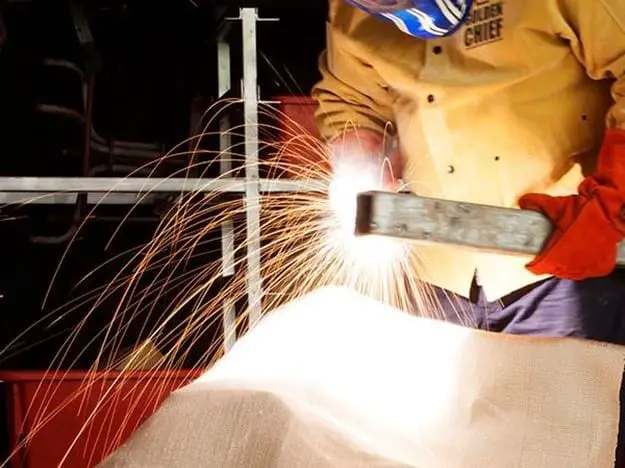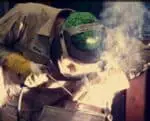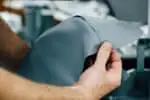Heat, molten metal, and splatter generated while welding are as much a danger for objects surrounding the welding area as they are for you. On top of wearing the right PPE, it’s also important to use a welding blanket.
A welding blanket should ideally be temperature-resistant and flame-resistant to offer protection from molten metal. Since there’s a lot of smoke and fumes that are emitted while welding, all the protective gears are bound to get dirty, and a welding blanket is no different.
It’s always very important to ensure that the welding blankets you’re using in your workshop are clean. If you’ve been wondering whether or not you can wash a welding blanket, then the answer is YES.
You can wash a welding blanket but you’ve got to practice certain precautions to ensure that the blanket doesn’t get damaged in the process.
In this guide, not only will you be able to learn how to wash a welding blanket but also the fabrics that welding blankets are made of, and much more. Dive in for all the details.
Can Welding Blankets Get Wet?
The very reason that people want to know whether or not welding blankets can be washed is that they’re considered to be fully waterproof.
However, in reality, welding blankets are water-resistant, not waterproof. Their purpose is to protect from heat and splatter. They can certainly get wet, but it doesn’t take a lot of time for them to get dry!
Fabrics Used for Welding Blankets – What are Welding Blankets Made Of?
Welding is of different types, so are welding blankets. The difference in the extent of heat they can withstand without melting depends upon the materials they’re made of.
We’ve listed some of the most popular fabrics used to make welding blankets. Have a look!
1.) Black slag is the most fire-resistant fabric used to make welding blankets since it can withstand temperatures as high as 3000°F.
2.) Silica is another popular choice for welding blankets. It can withstand heat and splatter to a whopping 2300°F.
3.) Vermiculite is a better option when you require vertical protection. It can withstand heat up to 2000°F. However, you should know that it can withstand such intense heat continuously for short time periods only.
4.) Fiberglass is the most popular choice of materials for welding blankets. Other than the fact that it can constantly resist heat up to 1000°F, aluminum fiberglass welding blankets can also reflect heat.
Leather and felt are two other very popular fabrics to make welding blankets. They offer insulation and are heat-resistant too. The problem with felt is that it isn’t long-lasting and leather, on the other hand, is very expensive.
Considering and evaluating every parameter, fiberglass, in our opinion, is the best material for welding blankets.
How to Wash a Welding Blanket?
Now that you know the types of materials that are used to make welding blankets, you would naturally want to know if you can wash welding blankets and how to do it safely.
First of all, it’s very important that your welding blanket is clean. For this purpose, you need to wash it. In order to wash it without damaging it, you’ve got to follow all the precautions listed in the upcoming sections!
#1. Controlled Water Temperature is Essential
Just because they can withstand grueling heat of thousands of Fahrenheit doesn’t mean you can wash them in intense heat. That’s not the way to wash a welding blanket.
Whether you’re washing yours in a washing machine or by hand, it’s important that you do not use water that’s more than 40°C. Period!
#2. Exposure to Bleach is a Strict No-No
You read it just fine – you should never use bleach (no matter how mild it is) to wash a welding blanket no matter what. Use very mild bleach-free detergents. Don’t use fabric softeners either.
Also, always use soft water to wash a welding blanket.
#3. Soaking Isn’t the Right Way
You don’t have to soak a welding blanket in water for minutes before you wash it. Wash it straightaway.
If you’re washing it by hand, dampening it is enough.
If it’s too dirty and you’re using a washing machine, turn on the gentle cycle immediately instead of letting the blanket sit in water for quite some time.
Also, don’t wash a welding blanket with other clothes, EVER! Wash it separately in a washing machine. A short cleaning cycle is enough.
If you have a leather welding blanket, washing it with your hands is a good idea instead of washing it in a machine. Using a saddle soap is by far the best way to clean a leather welding blanket.
Things to Consider When Buying a Welding Blanket
Washing a welding blanket without damaging requires basic info that we have already supplied you with. Now, it’s time we explain what you should consider when you’re buying a welding blanket. Have a look!
1.) The flame resistance should be high.
2.) The welding blanket must be coated with a flame-resistant material like vermiculite, acrylic, etc.
3.) Always buy the right size that can cover the entire length that you want to be protected.
4.) The welding blanket you’re buying should be able to withstand the temperature you usually work at. So, be very careful about the material the blanket is made of since different materials offer heat resistance to certain degrees of temperatures.
FAQs
Are Fiberglass Welding Blankets Safe?
There’s a reason that fiberglass welding blankets are so preferred. The very fact that they’re one of the most popular types of welding blankets declares that they’re very astoundingly safe.
They are insulated and flame-resistant. They guard against heat up-to a 1000°F as promised. As long as you don’t expose them to temperatures higher than what they’re made for, they will prevent fire outbreaks.
Do welding blankets burn?
No. It’s a misconception that a welding blanket will burn. Just because it is called fire-resistant not fire-proof doesn’t mean it will burn. What it means is, it will melt when exposed to temperatures higher than what they’re designed to withstand.
The very reason that they’re even used in the first place is that welding can cause a fire outbreak. When you have a welding blanket, instead of burning, it will start melting first, giving you enough time to take precautions so that a fire incident can be averted.
What is the difference between a welding blanket and a fire blanket?
Now that you know that a welding blanket doesn’t burn, you might be wondering what’s different between a welding blanket and a fire blanket.
To start with, a welding blanket in itself has two classifications: a welding thermal blanket and a welding fire blanket. The aforementioned guide explains everything about a welding thermal blanket.
A welding fire blanket is different from a welding thermal blanket in a way that the former is self-extinguishing. So, it’s an excellent option to prevent fire outbreaks due to sparks.
Concluding Thoughts:
A welding blanket can be washed without any damage to the surface when proper precautions are followed. You have to ensure that the temperature of the water isn’t more than 40°C when you’re cleaning a welding blanket.
All in all, we hope that you will now be able to choose a welding blanket suitable for your purpose and wash it properly without risking its quality.








